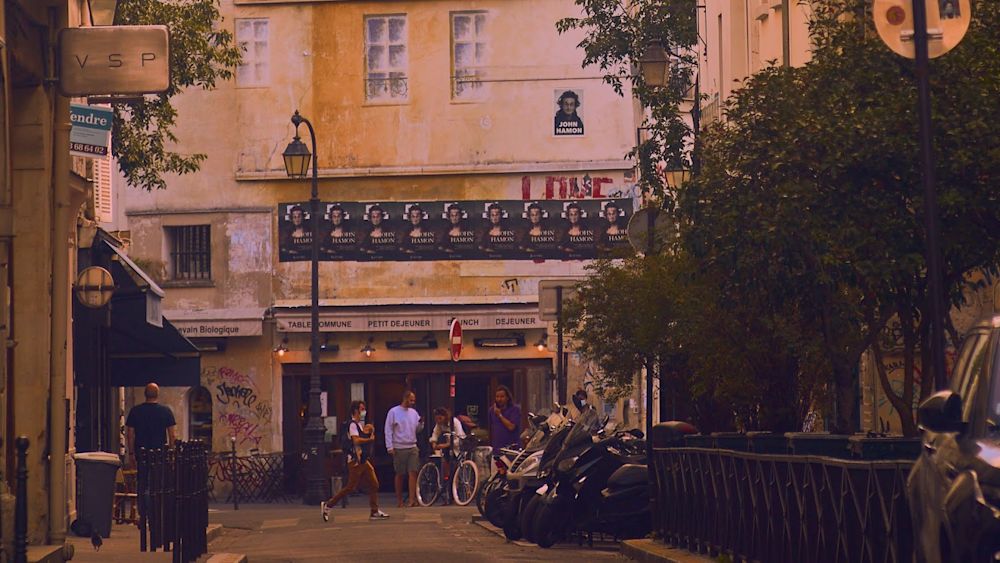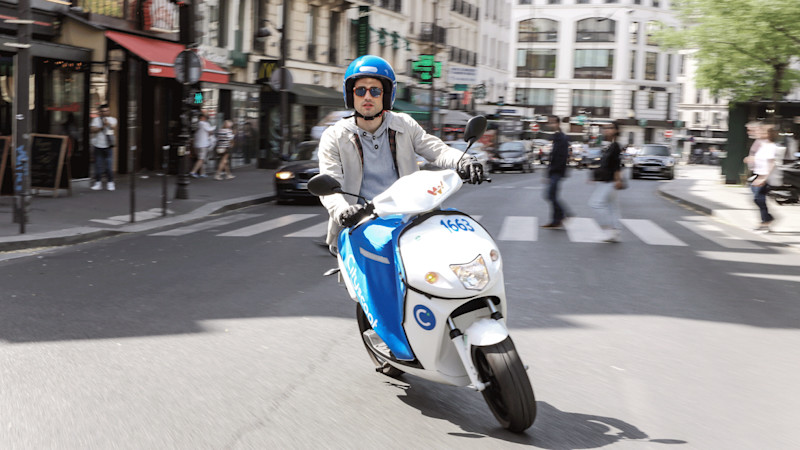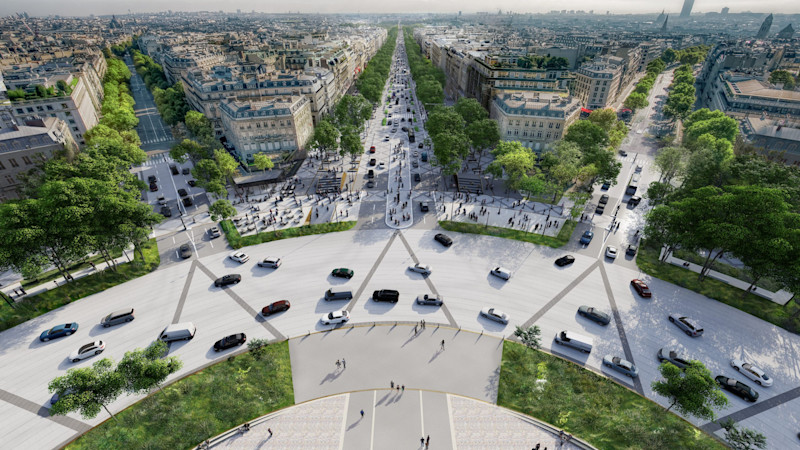- Iterate
- Meet The Team
- Reinventing Mobility in Paris
Table of contents
The pandemic, and a months-long transport strike that succeeded it, has accelerated the transformation of how people move around Paris. The Org looked into the new players and projects reshaping mobility in Paris to give a glimpse at what the capital could look like in the near future.

Dangerous Vehicular Cohabitation
Paris, which has historically gone under many waves of major urbanism transformations, is changing at a rapid pace, provoking at times confusion, mess, and exasperation among its inhabitants. One can remember how 12 electric scooters startups and their 20,000 vehicles invaded Paris all of a sudden in 2019, provoking a surge in accidents and uncontrolled dumping of broken devices in the streets and the Seine.
The city is now faced with an almost impossible challenge: The global urban reshaping of the city to smooth the cohabitation between many different modes of transport, like cars, bikes, electric mopeds, and electric scooters. Over the past few years, this cohabitation has proven to be progressively more and more difficult as many new mobility operators (Voi, Ufo, Bolt, Wind, and Tier, among others) have flocked to the capital at the same time without proper regulations and infrastructures to welcome their fleets of devices. In January 2020, after a month of strikes and the absence of public transportations, metropolitans were forced to adopt alternative means of transport, and correlatively the number of accidents on the road that month rose by almost 13% compared to January 2019.
Mobility has become a major topic of conversation and a source of frustrations and complaints among officials and inhabitants of the city. While not everyone agrees on how the city should change, there's a consensus about the necessity to reduce physical space taken up by cars, from roads to parking. Behind what is sometimes considered unfair “car bashing” lies a startling fact: 50% of the surface territory in Paris is dedicated to cars even though they represent only 13% of journeys in the city.
Biking and Walking in a Covid Era
If there's one winner from the successive confinements and curfews happening in Paris since early 2020, it's biking. French authorities had already started implementing initiatives to foster biking as the first way of moving around in the capital a decade ago, but their efforts have increased since the first confinement in March 2020. The new reality is that, in this Covid era, people are more afraid of taking public transports like subways or buses, and are therefore looking for alternatives that benefit social distance. Among all, biking has been met with the greatest enthusiasm.
On the government's side, a 20M€ ($23.8M) package to spur cycling post-lockdown has been unveiled during deconfinement, including a 50€ ($60) subsidy for bike repairs or tune-ups. Paris officials were especially concerned by the return of residents after an estimated 20 to 25% of its population of 2.2M fled to country homes or elsewhere before the nationwide stay-at-home orders came into effect on March 17.
The results are now there: Today, new cyclists account for almost six out 10 users of cycle lanes in Paris, per the Hôtel de Ville. Some 14% began cycling during the public transport strike of December 2019 and January 2020, before the first cases of coronavirus happened in France. The unreliability of public transportations, from recurring strikes to technical deficiencies to overcrowding, paved the way for this new biking revolution.
The sudden popularity of biking has translated into an unforeseen demand that surprised many companies in the industry. The retail chain Intersport, an international sporting goods retailer with 638 stores in France, announced in June that it was selling more than 4,000 bikes a day in the country — 2.5 times more than the previous year during the same period.
Ups and Downs of Vélib’ Métropole
It's no news, though, that the city has aggressively been in favor of biking since it started pushing bike-friendly initiatives more than a decade ago. The Parisian region has indeed been operating its own service of shared bikes, called Vélib’, since 2007. With 17,500 bikes, 7,000 electric bikes, and 1,400 stations across the area, Vélib’ is today the main shared bike operator in the capital.
Managed as a public service delegated to a private operator (JCDecaux between 2007 and 2017), Vélib’s popularity slowly declined due to unreliable or damaged bikes. A consortium, Smovengo, has been recently put in charge of the service to regain Parisians' hearts. In 2019, it said the service is down to 175,000 subscribers and 70,000 bike runs every day, a rough drop of 50% in trips and 40% in customers after many issues damaged the reputation of Vélib’. The unpredictable availability or reliability of those bikes has certainly convinced Parisians to invest in a personal bike instead.
Vélib' isn't the only mobility service to be the subject of criticism. The debacle that followed the sudden unleash of 20,000 electric scooters in Paris between 2018 and 2019 led the city to implement restrictive regulations to supervise their usage. Last July, the city chose Lime, Tier, and Dott as the only companies who could operate fleets of electric scooters in Paris. Each has been granted a two-year contract to deploy 5,000 electric scooters. The Santa Monica-based Bird, which had previously announced its ambition to make Paris its "second home," has remained silent since the announcement. The city also shared that it was installing some additional 2,500 parking spaces dedicated to electric scooters to avoid the narrow sidewalks of Paris becoming impracticable.
The Success of Cityscoot
In addition to electric scooters, Paris inhabitants also have access to electric mopeds to rent on the go through Cityscoot, a French startup running a fleet of shared mopeds. Founded in 2014 by Bertrand Fleurose, the company first launched its Parisian service in 2016 and has since raised 78.9M€ ($94M) to date. Cityscoot users can find and rent one of the 3,800 electric mopeds available in the city directly on the startup's mobile app for between 0.24€ ($0.29) to 0.34€ ($0.40) per minute.

Despite most employees being required to work at home, the 400-people company announced last July that it had seen the same level of usage in the region Ile-de-France as in 2019 at the same period, with over 400,000 monthly trips of around 16 minutes for an average of five kilometers. To facilitate the adoption of its service, Cityscoot has recently partnered with Uber to offer its service through the cab-hailing app, as well as launching a B2B program of a 100-minute credit at 20€ ($24) for enterprises to offer to its employees. The startup is now also present in many cities of Europe: Nice (2017), Milan (2019), Rome (2019), and Barcelona (2020).
“Of course, as all the other mobility providers, we were highly impacted by the different lockdowns and curfews,” said Cityscoot CMO Amandine Plas. “But what we can see is new users are adopting the service to avoid crowded public transport or traffic jam and enjoy driving in the open air. They rediscover sensations of pleasure and freedom by using our services, and particularly in the current context.”
Improving the Walking Experience in Paris
Paris Mayor Hidalgo isn't just about biking: she also wants to make Paris more pedestrian-friendly. At the end of her first mandate, a bit before the elections of June 2020, Hidalgo promised: "If I'm reelected, the Canal Saint-Martin will be made pedestrian between Stalingrad and République before summer."

The area, appreciated for its charming bridges and colorful restaurants and stores, has become a popular place for gatherings. It was packed with people a few weeks ago during a spell of warm weather, forcing police officers to disperse groups and forbid alcohol consumption in the zone.
Many other pedestrian-centric projects are the pipeline for Hidalgo's new mandate, especially as Paris will welcome the Olympic Games in 2024. For example, the surroundings of the Eiffel Tower will be made green and pedestrian-only, which include the Pont d'Iéna. The venture, which has been estimated to cost 107M€ ($127.4M), is scheduled to start at the end of 2021 and finish in 2024 but has been met with protests from elected representatives of the arrondissements concerned.

Last but not least, the Champs-Elysées will go under significant changes too. One of the most used roads of the city with some 64,000 vehicles a day - and therefore one of the most polluted zones - the Champs has lost the favors of Parisians. In 2019, the committee of the most renowned avenue in the world unveiled its project to "re-enchant" the area. More information and a video about the 150M€($178.9M) urban redesign have been shared earlier this year. It will be transformed into an “extraordinary garden where you’ll hear the singing of the birds,” per Hidalgo’s speech.
“I think we must not oppose mobilities: they are rather all complementary and each respond to a different need,” Plas said. “Electric mopeds are synonymous with freedom and speed. The challenge today is for cities to adopt regulations that encourage residents to change their habits. To be more moped friendly, they can in particular authorize them to circulate in the lanes reserved for buses, as in Oslo for example. We can also set up transition bonuses that can be used for mobility services like Cityscoot. Madrid does it, why not Paris?”
--
The Org is a professional community where transparent companies can show off their team to the world. Join your company here to add yourself to the org chart!
In this article


The ORG helps
you hire great
candidates
Free to use – try today